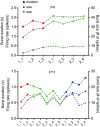Following the ontogeny of retinal waves: pan-retinal recordings of population dynamics in the neonatal mouse
- PMID: 24366261
- PMCID: PMC3979611
- DOI: 10.1113/jphysiol.2013.262840
Following the ontogeny of retinal waves: pan-retinal recordings of population dynamics in the neonatal mouse
Erratum in
- J Physiol. 2014 Aug 15;592(Pt 16):3697
Abstract
The immature retina generates spontaneous waves of spiking activity that sweep across the ganglion cell layer during a limited period of development before the onset of visual experience. The spatiotemporal patterns encoded in the waves are believed to be instructive for the wiring of functional connections throughout the visual system. However, the ontogeny of retinal waves is still poorly documented as a result of the relatively low resolution of conventional recording techniques. Here, we characterize the spatiotemporal features of mouse retinal waves from birth until eye opening in unprecedented detail using a large-scale, dense, 4096-channel multielectrode array that allowed us to record from the entire neonatal retina at near cellular resolution. We found that early cholinergic waves propagate with random trajectories over large areas with low ganglion cell recruitment. They become slower, smaller and denser when GABAA signalling matures, as occurs beyond postnatal day (P) 7. Glutamatergic influences dominate from P10, coinciding with profound changes in activity dynamics. At this time, waves cease to be random and begin to show repetitive trajectories confined to a few localized hotspots. These hotspots gradually tile the retina with time, and disappear after eye opening. Our observations demonstrate that retinal waves undergo major spatiotemporal changes during ontogeny. Our results support the hypotheses that cholinergic waves guide the refinement of retinal targets and that glutamatergic waves may also support the wiring of retinal receptive fields.
Figures










Similar articles
-
The role of early neural activity in the maturation of turtle retinal function.J Anat. 2001 Oct;199(Pt 4):375-83. doi: 10.1046/j.1469-7580.2001.19940375.x. J Anat. 2001. PMID: 11693298 Free PMC article. Review.
-
GABAergic regulation of spontaneous spike patterns in the developing rabbit retina.Neurosci Lett. 2015 Jul 23;600:137-42. doi: 10.1016/j.neulet.2015.06.003. Epub 2015 Jun 6. Neurosci Lett. 2015. PMID: 26054939
-
Retinal Wave Patterns Are Governed by Mutual Excitation among Starburst Amacrine Cells and Drive the Refinement and Maintenance of Visual Circuits.J Neurosci. 2016 Mar 30;36(13):3871-86. doi: 10.1523/JNEUROSCI.3549-15.2016. J Neurosci. 2016. PMID: 27030771 Free PMC article.
-
Cellular mechanisms underlying spatiotemporal features of cholinergic retinal waves.J Neurosci. 2012 Jan 18;32(3):850-63. doi: 10.1523/JNEUROSCI.5309-12.2012. J Neurosci. 2012. PMID: 22262883 Free PMC article.
-
Emergence of order in visual system development.Proc Natl Acad Sci U S A. 1996 Jan 23;93(2):602-8. doi: 10.1073/pnas.93.2.602. Proc Natl Acad Sci U S A. 1996. PMID: 8570602 Free PMC article. Review.
Cited by
-
A novel methodology to describe neuronal networks activity reveals spatiotemporal recruitment dynamics of synchronous bursting states.J Comput Neurosci. 2021 Nov;49(4):375-394. doi: 10.1007/s10827-021-00786-5. Epub 2021 Apr 27. J Comput Neurosci. 2021. PMID: 33904004
-
The Newborn's Reaction to Light as the Determinant of the Brain's Activation at Human Birth.Front Integr Neurosci. 2022 Sep 2;16:933426. doi: 10.3389/fnint.2022.933426. eCollection 2022. Front Integr Neurosci. 2022. PMID: 36118115 Free PMC article.
-
Building a circuit through correlated spontaneous neuronal activity in the developing vertebrate and invertebrate visual systems.Genes Dev. 2021 May 1;35(9-10):677-691. doi: 10.1101/gad.348241.121. Epub 2021 Apr 22. Genes Dev. 2021. PMID: 33888564 Free PMC article. Review.
-
The influence of spontaneous and visual activity on the development of direction selectivity maps in mouse retina.Cell Rep. 2022 Jan 11;38(2):110225. doi: 10.1016/j.celrep.2021.110225. Cell Rep. 2022. PMID: 35021080 Free PMC article.
-
A biophysical model explains the spontaneous bursting behavior in the developing retina.Sci Rep. 2019 Feb 12;9(1):1859. doi: 10.1038/s41598-018-38299-4. Sci Rep. 2019. PMID: 30755684 Free PMC article.
References
-
- Ames A, 3rd, Nesbett FB. In vitro retina as an experimental model of the central nervous system. J Neurochem. 1981;37:867–877. - PubMed
-
- Bansal A, Singer JH, Hwang BJ, Xu W, Beaudet A, Feller MB. Mice lacking specific nicotinic acetylcholine receptor subunits exhibit dramatically altered spontaneous activity patterns and reveal a limited role for retinal waves in forming on and off circuits in the inner retina. J Neurosci. 2000;20:7672–7681. - PMC - PubMed
Publication types
MeSH terms
Substances
Grants and funding
- BB/H023569/1/BB_/Biotechnology and Biological Sciences Research Council/United Kingdom
- BB/I001042/1/BB_/Biotechnology and Biological Sciences Research Council/United Kingdom
- G0900425/MRC_/Medical Research Council/United Kingdom
- BB/H023607/1/BB_/Biotechnology and Biological Sciences Research Council/United Kingdom
- BB/H023577/1/BB_/Biotechnology and Biological Sciences Research Council/United Kingdom
LinkOut - more resources
Full Text Sources
Other Literature Sources

